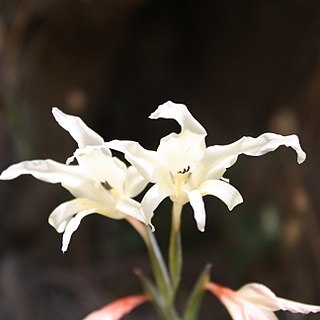Herb 40-80 cm tall. Corm 2-3 cm diam.; tunic fibrous; numerous subterranean bulbils often produced. Basal leaves linear-ensiform, 25-75 cm long, 5-15 mm wide, flat, with several prominent veins. Stem unbranched, with 1 or 2 reduced leaves. Spike distichous, rarely secund, straight, 3-8-flowered. Bracts narrowly lanceolate, 4-6 cm long. Flowers funnel-shaped, white to cream, green-tinged. Perianth tube 5-7 cm long, hardly curved, widened towards mouth; lobes ovate with long-acuminate, undulate tips, sub-equal, 4-6 cm long; dorsal lobe slightly hooded; lower 3 lobes recurved. Stamens arched in centre of flower; anthers c. 7 mm long. Style branches oblanceolate, hardly exceeding anthers. Fruit not seen.
Corm c. 2 cm diam., with numerous cormils at base. Stems of 60 cm high. Leaves almost = stems, linear, narrow, 1-1.5 cm wide, green tinged purple, sheaths deep red-purple. Flowers 10-12 cm long, to 8 cm diam., 3-8 in a loose, unilateral spike, greenish-cream; spathe-valves ? to ½ length of flower; tube c. 7 cm long, upper third widened and fluted; lobes 3-5 cm long, ± crinkled, tapering, with recurved tips, 3 lower lobes with central purple stripe at throat or purple colouring absent. Anthers greenish-blue. Style branches entire. Capsule not seen.
Cormous geophyte, 600-800 mm tall, corm with papery tunics. Leaves sword-shaped, glaucous. Flowers in a few-flowered, erect spike, bilabiate, white to cream, often with pink to red markings on lower tepals, perianth tube elongate-cylindrical, tepals attenuate, with undulate margins.
Like G. carneus but flowers longer-tubed with tepals attenuate and undulate to crisped, greenish white or cream-coloured, often with red markings on lower tepals.

